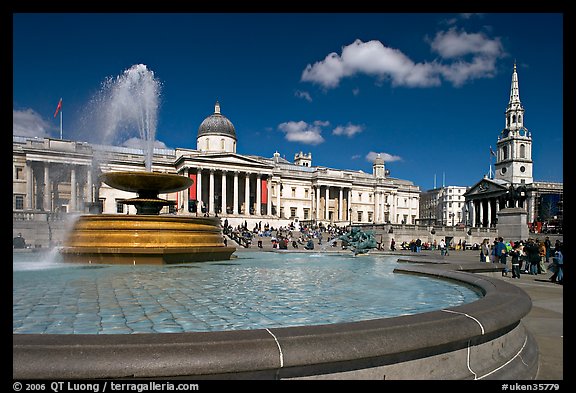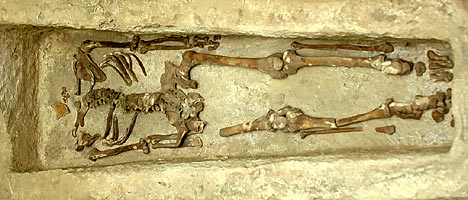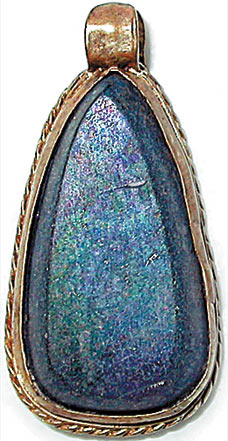Trafalgar Square skeleton forces historians to rewrite the story of Roman England
18th May 2007
Daily Mail

Trafalgar Square, London.
For 1,500 years, this skeleton of a wealthy Roman man was buried beneath Trafalgar Square.
Now its discovery is forcing archaeologists to rewrite the history of London.
Until the bones were found, along with jewels and other valuables, it was thought that the Romans had abandoned Londinium (a city that they had founded in 43 AD) around AD400 and the city was virtually desolate until the Saxons arrived in the seventh century.

This skeleton of a wealthy Roman man was buried beneath Trafalgar Square
But the Roman skeleton has been dated to AD410 and it was found surrounded by the graves of rich Saxons.

One had been buried with a pot that has been dated to AD500.
The finds - made during the £36 million redevelopment of St Martin-in-the-Fields church -prove the Romans remained in the city longer than previously thought and the Saxons arrived sooner.
Francis Grew, senior curator at the Museum of London, said: "For the first time we have the beginnings of a link between the Roman city (Londinium) and the Saxon London (Lundenwic) of the 600s.
"Before, we always believed London collapsed into ruins quite quickly after AD400.

St Martin-in-the-Fields churach in Trafalgar Square. The earliest extant reference to the church is from 1222, with a dispute between the Abbot of Westminster and the Bishop of London as to who had control over it. The church was rebuilt by King Henry VIII in 1542 to avoid plague victims from the area having to pass through his Palace of Whitehall. The church survived the Great Fire of London of 1666 which did not reach as far as the City of Westminster, but was replaced with a new building, designed by James Gibbs in 1721.
"What I find really quite moving is this Roman symbolises the end of the ancient world and was around just about long enough to see the beginnings of what would become modern London.
"It would have been quite frightening for him because he would have grown up in a world where the Emperor's face was on every coin and Roman officials and soldiers walked the streets.
"By the time he died the first Saxons would have probably started arriving from northern Germany, after centuries of no immigration.

Treasures: a gold and glass pendant (above) and a glass bowl
"Coins would have been replaced by barter. He would have felt quite isolated and disconnected."
Other graves found on the site date from AD600 and appear to be Christian, raising the possibility that St Martin-in-the-Fields was a sacred site for longer than had been thought.
The skeleton, pot and treasures will be on display at the museum from Thursday until 8 August.
dailymail.co.uk
18th May 2007
Daily Mail

Trafalgar Square, London.
For 1,500 years, this skeleton of a wealthy Roman man was buried beneath Trafalgar Square.
Now its discovery is forcing archaeologists to rewrite the history of London.
Until the bones were found, along with jewels and other valuables, it was thought that the Romans had abandoned Londinium (a city that they had founded in 43 AD) around AD400 and the city was virtually desolate until the Saxons arrived in the seventh century.

This skeleton of a wealthy Roman man was buried beneath Trafalgar Square
But the Roman skeleton has been dated to AD410 and it was found surrounded by the graves of rich Saxons.

One had been buried with a pot that has been dated to AD500.
The finds - made during the £36 million redevelopment of St Martin-in-the-Fields church -prove the Romans remained in the city longer than previously thought and the Saxons arrived sooner.
Francis Grew, senior curator at the Museum of London, said: "For the first time we have the beginnings of a link between the Roman city (Londinium) and the Saxon London (Lundenwic) of the 600s.
"Before, we always believed London collapsed into ruins quite quickly after AD400.

St Martin-in-the-Fields churach in Trafalgar Square. The earliest extant reference to the church is from 1222, with a dispute between the Abbot of Westminster and the Bishop of London as to who had control over it. The church was rebuilt by King Henry VIII in 1542 to avoid plague victims from the area having to pass through his Palace of Whitehall. The church survived the Great Fire of London of 1666 which did not reach as far as the City of Westminster, but was replaced with a new building, designed by James Gibbs in 1721.
"What I find really quite moving is this Roman symbolises the end of the ancient world and was around just about long enough to see the beginnings of what would become modern London.
"It would have been quite frightening for him because he would have grown up in a world where the Emperor's face was on every coin and Roman officials and soldiers walked the streets.
"By the time he died the first Saxons would have probably started arriving from northern Germany, after centuries of no immigration.

Treasures: a gold and glass pendant (above) and a glass bowl
"Coins would have been replaced by barter. He would have felt quite isolated and disconnected."
Other graves found on the site date from AD600 and appear to be Christian, raising the possibility that St Martin-in-the-Fields was a sacred site for longer than had been thought.
The skeleton, pot and treasures will be on display at the museum from Thursday until 8 August.
dailymail.co.uk
Last edited: